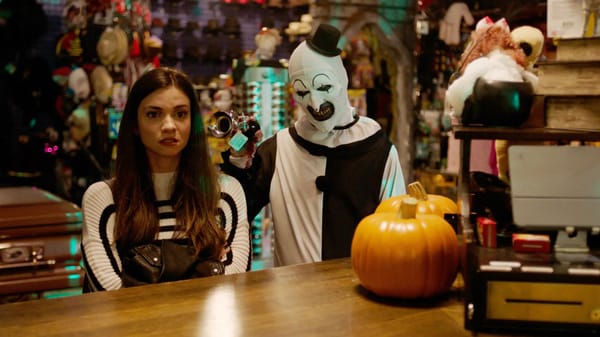Damien Leone’s slasher film Terrifier 2 is the season’s unexpected hit, earning more than $11 million at the box office. It is also unrelenting, brutal, nauseating. The sequel to 2016’s Terrifier picks up where its predecessor immediately left off: After having his brains blown out by cops at the end of the first film, the gleefully violent slasher villain Art the Clown is resurrected by a demonic entity and goes on another ultra-graphic killing spree. It’s no easy feat to stomach watching an innocent girl get her eye sliced out, flayed alive, and arm snapped off in unbelievably realistic physical effects in rapid succession. Furthermore, Leone refuses to dull the violence through gore humor affectations or the “nod and wink” postmodernism of, say, George Romero. Everything in Terrifier 2 leaves open the possibility that the artist behind it is genuinely disturbed. It is disgusting, morally repugnant—and a genuine break with increasingly stultified highbrow horror.
During the 2010s, horror became the de facto genre of the rising independent American auteur. A24 Films, an independent studio, sought to “elevate” itself beyond the single-minded violence and gross-out factor of the slasher and splatter cinema of yesteryear and into the realm of high-minded arthouse. This tendency did, in fact, launch the careers of some unique American filmmaking talents and was responsible for some of the decade’s most interesting films—among them, Jonathan Glazer’s Under the Skin (2013), Robert Eggers’s The VVitch (2015), and Ari Aster’s Hereditary (2018).
But as with so many cultural developments over the previous decade, this progression was easily astro-turfed, politicized, and eventually made dreadfully formulaic. Often, these films scare you less than they beat you over the head with politics. Jordan Peele’s work was at first praised as radical and subversive with the release of Get Out (2017) but was soon shown to be hollowly political with the release of the dismal Us (2019). Similarly, Carlo-Mirabelle Davis’s Swallow (2020) presents a trite, feminist line of argumentation with a pseudo body-horrific peg, its creepiness cancelled out by its moral preening. Even Aster followed up the superb Hereditary with Midsommar—a chick flick encrypted as horror that had little to say beyond: Men are selfish and emotionally unavailable, so it’s OK to burn them alive as an initiation into your creepy new cult. The point is,“A24 horror” grew stale and formulaic. In attempting to subvert the hallmarks of the horror genre, it ended up codifying a new genre. And that genre sucked.
Leone’s first Terrifier, from 2016, can now be read as a negation of the A24 horror formula that was then still in its infancy. This was no “arthouse horror.” Leone’s work carries on the legacy of films like Scott Spiegel’s 1989 slasher masterpiece, Intruder: It isn’t about what Terrifier says, it’s about what Terrifier does. Its creativity lies in its imagery and stomach-churning violence, not in any cultural critique. Terrifier doesn’t even have much of a plot and is totally devoid of sympathetic protagonists. All the characters are mere canon fodder for the creative murders and bodily dismemberments perpetrated on them by Leone’s true creation, the character of Art the Clown—a fascinatingly jovial, visually unforgettable, and gleefully sadistic presence.
Much like German underground director Marian Dora, Leone is a makeup artist turned filmmaker of sickeningly brutal cinema who gives more attention to art direction and physical effects than he does narrative. The first Terrifier, made on a $35,000 budget, thrilled horror audiences in a manner that has eluded slasher films for decades. After securing financing from a few small investors, Leone launched a fundraising campaign to produce a sequel. The campaign earned $250,000 in two weeks, exceeding its projected goal by 430 percent.
With this larger budget, Leone made Terrifier 2 a more proper work of cinema than its predecessor, creating a full story featuring two siblings, a teenage girl and a young boy, that the audience could root for. The film follows the kids on Halloween night as they attempt to evade Art the Clown. The final product is so violent and ugly that I felt queasy watching it (and I’ve watched everything), but in a year that has seen a number of undeniable masterpieces—Vortex and Blonde among them—Terrifier 2 is one of the most exciting and creative works of cinema of 2022.
“Americans are tired of having to justify their pop cultural bloodlust with high art pretensions.”
Leone’s success suggests that Americans are tired of having to justify their pop cultural bloodlust with high art pretensions. Antonin Artaud proposed a distinction between a “coarse cruelty” based in bloodshed and a “pure cruelty, without bodily laceration.” Leone believes no such distinction should be made. This is a work of art that doesn’t need deeper meaning. The only justifiable thing about Terrifier 2 is the joy it demonstrates in its own craft and structural artifice.
One of the protagonists in Wyndham Lewis’s 1918 modernist novel Tarr often worries that he will be expected to apologize for his brutal behavior as an artist but is “determined not to do so.” This is the virtue of the Terrifier franchise and Damien Leone. Casting aside the qualms of arthouse horror, it offers us unapologetic cruelty.
